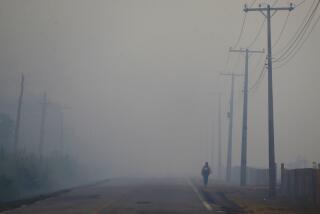Citizens of Brazil’s Valley of Death Breathing Easier After Two Years of Cleanup
- Share via
CUBATAO, Brazil — People are breathing cleaner air in this industrial city, long considered one of the world’s most polluted and known in Brazil as the Valley of Death.
The United Nations-affiliated World Health Organization and local ecological groups say that a $500-million government cleanup program has produced substantial improvements in pollution levels in Cubatao, 37 miles southeast of the financial-industrial center of Sao Paulo and next door to the coffee port of Santos.
When the state’s Environmental Control Agency began the anti-pollution campaign two years ago, the smoke stacks at Cubatao’s 23 industries spewed out almost 500 tons of pollutants a day. Today the level has dropped to about 165 tons, Benedito da Conceicao, the agency’s local manager, said in an interview.
In the meantime, many of Cubatao’s 100,000 inhabitants were afflicted by pulmonary edemas, bronchial infections, skin cancer, leukemia and other diseases caused by the toxic emissions from the city’s oil refinery and steel mill and from fertilizer, petrochemical and cement plants.
No Precise Statistics
No precise health statistics are available from before or after Cubatao’s cleanup, but Conceicao said that he was “certain health standards have improved since 1984.”
Edilberto Pereira, a 42-year-old luncheonette owner, agreed.
“I’ve lived here all my life and it was only last year that I stopped having trouble breathing,” he said. “And the headaches that I had almost every day are also gone. There is no doubt in my mind that the air here has never been cleaner.”
Several of his customers nodded in agreement.
Troubles Linger
But some neighborhoods, particularly those near factories where pollution has yet to be conquered, are still troubled.
One such area is Vila Parisi, a sprawling shantytown of about 5,000 people.
“The air here is just as polluted as it was when I first arrived 10 years ago,” Adelaide Maria da Silva, a 40-year-old housewife, said. “Just about every other day my four children have trouble breathing, and I have to rush them over to the health station.”
The Vila Parisi Health Station still treats about 30 to 40 people a day for eye infections and breathing problems.
‘Tolerable levels’ Sought
“Of course there are still health problems because pollution still exists,” Conceicao said. “In fact Cubatao will never be a pollution-free city. The only way to accomplish this would be to shut down all the industries, and that would be economically unviable.”
He said the objective was to bring pollution to “tolerable levels” by the end of 1988 or 1989.
Cubatao’s rapid industrialization began in the 1950s when several companies, attracted to its proximity to Santos and Sao Paulo, installed plants here.
But no attention was given to the surrounding mountains that prevented proper wind dispersal and trapped toxic industrial emissions. The city became wrapped in a permanent shroud of poisonous gases, and many pollutants returned to the soil in the form of acid rain. At first people put up with it, maintaining that “pollution meant progress.”
Conceicao said the $500 million allotted for the pollution-control program was for installing filters, incinerators and other pollution treatment systems in Cubatao’s 23 industries.
More to Read
Sign up for Essential California
The most important California stories and recommendations in your inbox every morning.
You may occasionally receive promotional content from the Los Angeles Times.










